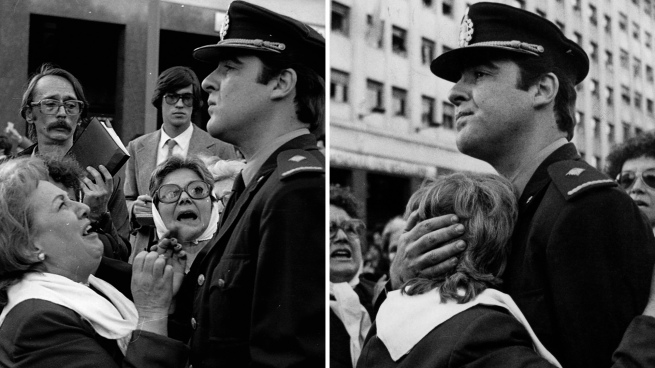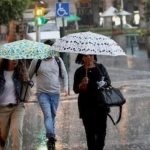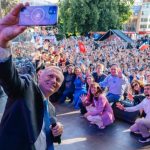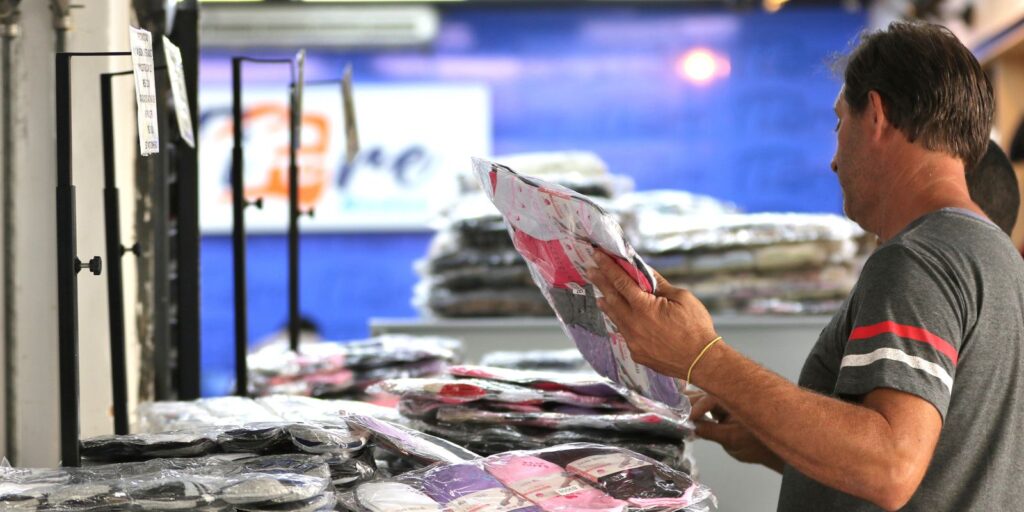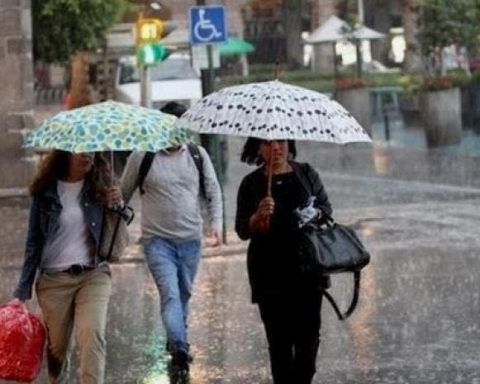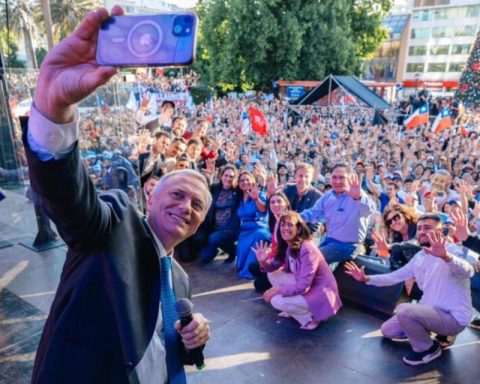40 years ago, that was the response that Colonel Rafael De Piano, inspector of the Télam agency in October 1982, gave to the photographer Jorge Sánchez after seeing the images in which the Mother of Plaza de Mayo Susana Leguía rebuked the repressor Carlos Enrique Gallone crying, because it prevented him from reaching the Plaza de Mayo to participate in the March for Life, in which a group of human rights organizations was going to claim in the middle of the military dictatorship for the appearance of the detained-disappeared alive.
The image that this agency decided to publish was a photo of DyN recorded by Marcelo Ranea. The photographer captured a scene that actually lasted a nanosecond: a moment in which Gallone “embraced” Leguía when the Mother jumped on him to try to reach the Plaza de Mayo, thing that prevented them.
The repressor convicted of the Fatima Massacre took advantage of the moment to feign a good relationship between the military and human rights organizations.
Just a frame that did not record what had happenedbut exactly the opposite, but which served to stage the pantomime that the security forces of the civic-military dictatorship lovingly treated the relatives of the disappeared. And that photo went around the world. A real photo that was the quintessential lie.
Télam carried out a thorough investigation in his archive and found the six frames of photographer Jorge Sánchez that had been censored: they were deliberately named with an incorrect date so that they could never be found.
The search for this true historical document was carried out in an effort to correct the distorted memory of the past in order to think about the future with solid foundations, as the Télam agency already did with the coverage of the 40 years of Malvinas. The documentary The means of war reveals the censorship in the coverage of the war that was made both from the private and public media. It is a valuable product of an archive recovery policy that seeks to discover the historical truth about relevant political events.
These are the frames censored during the civic-military dictatorship, which were found 40 years after being taken by Jorge Sánchez.





Nora Cortiñas, direct witness
“It was not usual for this mother to come because she worked, she attended a hairdressing salon, so she did not know our codes, which were never to touch or let yourself be touched by a police officer. In her desperation Gallone was on top of her, who took advantage of her moment to hug her and it seemed that the police treated her mothers well. But Susana’s gesture was one of desperation and fury,” Nora Cortiñas, a witness at that moment and a reference for the Mothers of the Plaza de Mayo Línea Fundadora, told Télam.
The memory of Jorge Sanchez
“When the head of photography at that time saw the photo, he uploaded it to the newsroom and from there the director of the agency, who was De Piano, bounced it. He ordered all the negatives, put them away, they parted ways, He called me to his office and the phrase was: ‘This should not come out because it could have consequences for you and your family.’ That is why those negatives were separated and later, surely over time, they will have put them with different dates so that no one finds them.
“I remember that behind De Piano’s desk, he standing and me in front, the last thing he advised me was that the material should not come to light for my good and that of my family. And he added: ‘Retreat’. So I left “.
But he had time to preserve the material, as well as other photos of that day’s coverage that were also recovered from the Télam archive.
Photos March for Life Sanchez, Eckstein and Ventura.
“In that time, Before going up to De Piano’s office, I managed to make a copy for myself and left it wet on top of the cabinets we had where we kept the equipment. The next day I came very early, I kept the originals and took them home. It is part of the story of how I was able to rescue the photo,” recalled Sánchez.
The international impact
The scene of the “hug” was the one that prevailed. It was selected for the cover of the Clarín newspaper the next day under the title “Peaceful concentration in the center” and republished the next day in an editorial. In addition to the newspapers Clarín and La voz in Argentina, it was published by the New York Times and the Miami Herald of the United States.

El País from Spain, Excelsior from Mexico, also reproduced it. It was later used several times in editorials that tried to impose the idea of reconciliation between the security forces and society and was even internationally awarded the King of Spain Award.
The day Sánchez posted
The threats of the intervener of Télam in the dictatorship had a basis.
On the morning of October 8, Sánchez was crossed by a vehicle at the intersection of Ceballos and General Paz streets, transferred to an interrogation in a clandestine detention center where he received verbal and physical abuse. and they “returned” him after a few hours on Nogoyá and General Paz streets.
On October 5, 2020, Sánchez shared the image on Facebook with a text which said: “I share this image today after it was censored on that same day by the president of the Télam agency, Colonel (Rafael) De Piano when, behind his desk, without any dialogue, a voice of command was heard: ‘ This here does not have to be published for your own good and withdraw’”.
“The next morning another image was reflected on all the front pages of the Argentine newspapers that reflected a reality opposite to that of that historical moment of that march and walked to an international award.”
“Two days later, on the morning of 10/8/1982, a vehicle passed me at the intersection of Ceballos and General Paz streets to take me to an interrogation in a clandestine detention center with verbal and physical abuse to return me after a few hours on Nogoyá and General Paz streets”. Today I wonder if this image had caressed the presses that day it could have changed history”.

A twice missing photo
Alejandro Amdam is a photojournalist and was the editorial secretary of Télam’s photography section for 22 years, until his recent retirement. He was in the march for life and remembers the moment in the photo with details. “I remember seeing the whole sequence, the photo that represents what happened is Jorge’s,” he said.
In 1981, during the dictatorship, a group of photojournalists called Grupo de Reporteros organized an exhibition with the photos that the media did not broadcast. They were at high risk because he remembers the presence of the infamous green Falcon at the door and the military inside commenting on the photos.
In 1982 they organized the exhibition again and the photo of Jorge Sánchez was present. He had decided to publish his photo of the Mother crying and next to it the other one, the one with the hug. He titled the work “Cara y Ceca”.
The opening night the photo was stolen. “We have a missing photo,” he told Télam.
The recovered wires
The lying photo was accompanied by cables that were also recovered by the archive section of Télam.
In them it was warned before its completion that the mobilization was not authorized by the Ministry of the Interior.
“The national government decided not to authorize the performance of an act scheduled for tomorrow by different groups, indicating that this meetingn does not entail authentic purposes of common good as it aims to deepen the wounds caused by the terrorist war that devastated the republic in the past decade”, says one dated October 4.
And in one that gives an account of what happened after the mobilization, the following can be read: “Without disorders or arrests, the march organized by human rights entities that did not achieve the initial purpose of reaching the Plaza de Mayo ended at 7:00 p.m. on Avenida Belgrano and Paseo Colón.. The march had not been authorized by the Ministry of the Interior, despite which the police authorities granted a group of ten people access to the Government House to deliver a memorial.

The presence of tanks and mounted police seriously calls into question the peaceful atmosphere that the cable wants to convey.

Not satisfied with having simulated a hug with a Mother of Plaza de Mayo, the repressive Gallone tried to use the photo of the lie to get his impunity.
In 2008, the repressor was sentenced to life in prison for what became known as the Fatima Massacre: on August 20, 1976, 30 people were shot and their bodies later dynamited in Pilar.
In his defense, Gallone used the photo of the false hug as proof of the good relationship that united him with society in general and with human rights organizations in particular.
He failed to impose that lie. Sometimes it is necessary for time to do its work for the truth to come to light.
In this case, 40 years for Argentine society and the world to see the six photos that censored Jorge Sánchez and cost him the mistreatment and indignation of attending the Dantesque spectacle of a lie that toured the world.
Because it is not true that a picture is worth a thousand words.
*The recovery of this historical material from the Télam Agency was the product of the commitment of Alejandro Ferro, Jorge Ortega and Claudio Adornetto from the Journalistic Archive; and Luis Ramirez, Walter Romero, Emilia Luna, Carla Conçalves, Lorena Olivera, Rodrigo Balbuena, Vanesa Gomez, Aylin Loponte, Julia Cao, Sabino Cabrera and Mariana Torres from the Photographic Archive.
